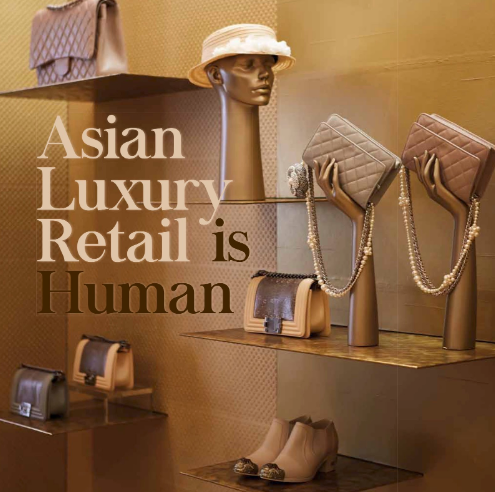
Digital giants such as Alibaba and Amazon, and online luxury specialists like Farfetch, Yoox and Net-a-Porter are thriving in Southeast Asia. Yet, even as online commerce sales is rising five times faster than the overall market, forecasters agree on one thing: online sales for luxury will flatten at around 25 percent of the total market by 2025. Farfetch was bracing itself for this plateau when it clinched a partnership with Chanel in 2018. Their goal is to become the leading luxury retail operating system.
What’s more exciting is that the fast growth rate of luxury in regions like Asia implies that digital is not necessarily cannibalising physical retail in dollar terms. For example, offline remains the dominant channel in China with just seven percent of luxury sales occurring in official online channels.
Despite the good news for physical retail, luxury companies cannot be complacent. These brands need to evolve and adapt to the new digital reality. The process of adaptation entails two major steps for luxury retailers in Asia: reinventing the role of the physical store and addressing the talent management challenge.
Physical retail must become experiential
The paradox is that adjusting to digital commerce does not entail just digital transformation. I had the chance to interview 15 CEOs and senior executives at the 2018 LVMH-SMU Luxury Research Conference in Singapore and the Arab Luxury World Conference in Dubai. These conversations identified a key insight into the future of the luxury brick-and-mortar space—to thrive in a digital world, physical retail needs to stop being transactional and become relational, emotional and experiential.
Some Asian companies are showing how this can be done. Australian skincare brand Aesop has a localised design strategy for its stores. When designing a boutique, it places a great emphasis on aesthetic elements, the style of adjacent shops, as well as the local culture. Its knowledgeable staff has a discreet presence and know how to invite customers into the store to smell and feel its cosmetics. In the words of its CIO, “We want our physical stores to not just be a place for product distribution, but hopefully a haven from the busy world outside, so customers can experience something they love and enjoy.”
Meanwhile, the Mercedes ‘me Store’ in Hong Kong has a special design, which includes an entrance, a living room, lounge areas, a garage (showcasing the latest models), an in-store boutique, and all-day dining options for guests, from breakfasts to late-night dinners. Mercedes frequently introduces different kinds of themes and lifestyle activities. The store encourages its visitors to join the company’s Facebook and Instagram communities. The result? The Mercedes ‘me Store’ becomes not just a store, but a lifestyle venue where customers experience the brand while, “navigating through a comfortable and familiar space that feels like home.”
In a similar vein, Seoul-based eyewear label, Gentle Monster, is pushing the boundaries of physical retail. It designed its flagship stores (eight in China, five in Korea and two each in Singapore, the U.S. and the U.K.), to be unique creative environments. Each one carries an artistic and multisensory installation, which allows visitors to immerse themselves in alternative realities. Examples include Nietzsche’s ‘Thus Spoke Zarathustra’ quote—confronting men’s desire to break free from the inescapable wheel of life, the laws of entropy, and the creation of a post-apocalyptic world. At the same time, its products are exhibited like museum pieces. According to its CEO, “Consumers are not paying for our products, but rather the feeling of experiencing something new and fresh.”
The talent management challenge of Asian luxury retailers
Experiential retail is in large part about forging differentiating experiences through personal relationships between in-store sales assistants and customers. In this environment, the competitive advantage comes from well-educated, extremely knowledgeable and passionate talent with good storytelling skills—not from technology. Technology will only be a means to help talented sales employees. For luxury retailers, talent acquisition and retention at the store level is more critical than ever.
Consider two examples to understand how much of the experience will come from selected talent. At the Nespresso flagship store in Singapore, the baristas at the Tasting Bar educate customers on the company’s wide range of coffee products. In another section of the store, they also invite them to test Nespresso’s new machines and learn how to, “select various foam textures, temperatures and quantities to create beautiful milk foam designs for every cup.” At Apple Inc., 40 percent of retail staff is dedicated to service and support, not sales. The company has recently started to change its store layout to emphasise communal gathering and encourage interactivity. The stores organise ‘Today at Apple’ sessions, a series of educational sessions designed to inspire customers to learn new skills, pursue a passion and join a community.
Nevertheless, throughout Eastern Asia, luxury brands struggle to recruit and retain top talent to work in their stores. While Asian consumers love luxury goods, top talent does not find working in a luxury store aspirational enough. This is partly cultural—serving in a store when one has a university degree is not considered a prestigious career. In self-image conscious societies, parents put pressure on their children to work instead in financial services, professional industries and technology companies. There is also a generational issue. All over the world, a growing number of young talent prefer to work for start-ups, which are perceived to be trendy and more educative.
Finally, the lack of talent also stems from an industry shortcoming as companies have never been good at showcasing retail as a career. Today, most luxury brands fail to align themselves with the aspirations of the younger workforce. For example, luxury brands are alarmingly absent from employer rankings. If you look at major rankings, there are no luxury brands in the top 20! Luxury brands need to change and legitimise the luxury retail career path for all staff, particularly for the younger generation. Getting the retail talent strategy right in Asia is not trivial. Asia-Pacific markets make up more than half the sales of brands like Prada and Burberry. Chinese consumers alone represent a third of the global luxury market.
How to legitimise the luxury retail career path
There is a clear disconnect between demand and supply in luxury retail talent in Asia. Luxury retailers are increasingly looking for a more educated, more entrepreneurial type of store employee, while the new generation in Asia appears reluctant to embark on a luxury retail career. Reinventing the consumer experience will start, first, by reinventing the employee experience within each luxury firm. To capture the hearts and minds of top talent in Asia, luxury senior executives will need to follow at least three paths.
Path 1—Create A Value Proposition for Talent
Today, sales advisors are rewarded based on the number of transactions they make, not on the relationships they build. So, it is just the sales dimension of their role that is rewarded. In a more relational retail model, store advisors would keep a focus on sales while also being recognised for assuming other roles. For example, they could develop storytelling skills or coach customers. They might also focus on public relations and organising events in their territory. Thus, if the breadth of roles and assignments expands considerably, opportunities for development and variety in the job will also increase. This, in turn, can make store positions more attractive for smart people. One of the coaches in the Fendi stores in Dubai developed such a close relationship with the Emir’s daughter that she asked the coach to plan her wedding! In Singapore, Céline recently launched a ‘Talk Series,’ where the brand invites its customers—all highly successful professionals—to network and attend the presentation by one customer who shared her experience on a topic. As some of these events take place in the store, the staff could be involved in organising these events.
Creating an attractive income proposition is imperative. If luxury brands want to feel authentic, they will do better if they can attract talent who have an experience of luxury in their lives, rather than tell a story in the stores that they themselves do not live and breathe. Economising on salaries will not help.
Path 2—Clarify the Sense of Purpose of Luxury
Younger generations are increasingly interested in the ‘why’ of things. They want meaning and purpose. Luxury brands need to connect with this demographic by embracing technology (millennials demand seamless transition between online and offline), and by ‘walking the talk’ on issues that matter to the millennials, such as sustainability, transparency, good citizenship and ethics. Companies like Gucci, Tag Heuer, Estée Lauder, Sephora and others have launched initiatives to understand the millennial psyche. These include the creation of boards and shadow committees made up of millennials and working with individuals and networks of people who come from the new generation.
To be more credible and therefore position themselves as attractive employers, luxury brands should clarify and communicate what their values and societal benefits are, which could entail contributing to civilisation through artistic creation and empowerment of the individual. Also, by creating opportunities for development that go beyond training, luxury retailers might provide a greater sense of purpose for talent.
Path 3—Improve Communication and Widen Recruitment Approaches
Luxury brands have traditionally preferred to promote internally, giving priority to their staff. For instance, the CEO of Louis Vuitton for Asia Pacific started his career on the shop floor. However, this is not always well communicated to young recruits. Luxury brands can offer a rewarding career trajectory beyond the store—one that includes international assignments and managerial positions.
Luxury brands also prefer to recruit for specific profiles from a narrow group of hospitality management and business schools. They should consider attracting people with different backgrounds, such as those from art and technology schools, given that creativity as well as technology will be important ingredients for future talent in luxury retail. Luxury firms in Asia should also participate in employer rankings and embrace some of the best human resource practices found in other industries and companies.
In sum, luxury brands in Asia need to prepare for the future of retail distribution. In doing so, they must revisit the role of the physical store and take concrete steps to attract and promote talent.
Originally published by SMU Asian Management Insights, 22 May 2019 by Dr Stéphane J.G. Girod. Access the case in full here.
As Asian luxury brands recognise the need for renewing their focus on their brick-and-mortar stores, they must also plan for the forecasted plateau in online commerce by 2025. Digital marketing remains essential to the growth of luxury retail, especially with data suggesting digital in no way detracts from offline profitability.
SMU Academy’s Professional Certificate in Digital Marketing equips professionals with the skills they need for continual advancement in a digital economy. Programme participants learn how to promote, distribute, and price products and services in the digital space, as well as to create online experiences that complement experiential physical retail in luxury and other retail industries.
